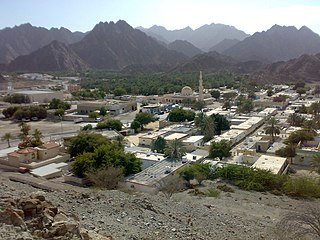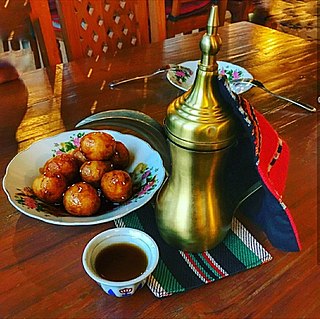
Global Village in Dubai is located on Sheikh Mohammed Bin Zayed Road E 311 road Dubai. It combines cultures of 90 countries across the world at one place. It claims to be the world's largest tourism, leisure, shopping and entertainment project. It is the region's first cultural, entertainment, family and shopping destination. Every year, it has over 5 million visitors over an area of 17,200,000 sq ft (1,600,000 m2). The current admission fee is AED 20.

Jumeirah is a coastal residential area of Dubai, United Arab Emirates mainly comprising low rise private dwellings and hotel developments. It has both expensive and large detached properties as well as more modest town houses built in a variety of architectural styles. The area is popular with expatriates working in the emirate and is familiar to many tourists visiting Dubai.
Al Khan is a southern suburb of the city of Sharjah, United Arab Emirates. The suburb is located on the Al Khan Bay, which serves as a boundary between Sharjah and Dubai. Until recently, the area was deserted and home to a collection of crumbling traditional coral and adobe houses, but it now houses the Sharjah Aquarium. A number of the older buildings are being restored to create a heritage area.
DakshinaChitra is a living-history museum in the Indian state of Tamil Nadu, dedicated to South Indian heritage and culture. It is located 25 kilometres (16 mi) to the south of Chennai. Opened to the public on 14 December 1996, the museum was founded and is being managed by the Madras Craft Foundation (MCF). The MCF was established in 1984. Deborah Thiagarajan, an Indian art historian of American origin, governs the museum. The museum is built on 10 acres (4.0 ha) of land taken on a 33-year lease from the Government of Tamil Nadu. Located at Muttukadu, on the East Coast Road connecting Chennai and Pondicherry, the site overlooks Bay of Bengal.

Sheikh Saeed Al Maktoum House is a historic building and former residential quarters of Saeed bin Maktoum Al Maktoum, former ruler of Dubai in the United Arab Emirates.

Hatta is an inland exclave of the emirate of Dubai in the United Arab Emirates. Formerly an Omani territory, its ownership was transferred to Dubai in or around 1850.
Art in Dubai is an emerging activity in Dubai, United Arab Emirates. New galleries such as Carbon 12 Dubai, art fairs, artists, art patrons and collectors have grown in number.

Sharjah is the third-most populous city in the United Arab Emirates, after Dubai and Abu Dhabi, forming part of the Dubai-Sharjah-Ajman metropolitan area.

Al Fahidi Historical Neighbourhood is a historic district in Dubai, United Arab Emirates (UAE).

Al Jaddaf, also spelled Al Jadaf, is a locality in Dubai, United Arab Emirates (UAE). Located in western Dubai in Bur Dubai, Al Jaddaf is bordered to the north and east by the Dubai Creek, to the south by Zabeel, and to the west by Umm Hurair 2.

Sheikh Maktoum bin Mohammed bin Rashid Al Maktoum is the Minister of Finance of the United Arab Emirates, Deputy Ruler of Dubai and Chairman of Dubai Media Incorporated. He was named as deputy ruler in February 2008 when his elder brother Hamdan was made crown prince. He served as deputy ruler alongside his uncle Sheikh Hamdan bin Rashid Al Maktoum until the latter's death in March 2021. Since then, he has been the sole deputy ruler under his father Mohammed bin Rashid Al Maktoum's reign. In September 2021, he was appointed Deputy Prime Minister and Finance Minister of the UAE.

Emirati cuisine is the local traditional Arabic cuisine of the United Arab Emirates. It is part of the Eastern Arabian cuisine and shares similarities with cuisines from neighboring countries, such as Omani cuisine and Saudi Arabian cuisine, as well as influences from different Middle Eastern and Asian cuisines.
The Abu Dhabi Authority for Culture & Heritage was a statutory body in the United Arab Emirates that administered cultural heritage in the Emirate of Abu Dhabi. In 2012, it merged into the Abu Dhabi Tourism & Culture Authority.
The culture of Dubai, an emirate of the United Arab Emirates. Simultaneously, increasing globalization and the settling of various immigrant groups have transformed the city into a melting pot of different nationalities and have given rise to a cosmopolitan culture that is in sync with other global cities. The UAE culture mainly revolves around the religion of Islam and traditional Arab culture. The influence of Islamic and Arab culture on its architecture, music, attire, cuisine, and lifestyle are very prominent as well. Five times every day, Muslims are called to prayer from the minarets of mosques which are scattered around the country. Since 2006, the weekend has been Friday-Saturday, as a compromise between Friday's holiness to Muslims and the Western weekend of Saturday-Sunday. In 2005, 84% of the population of metropolitan Dubai was foreign-born, about half of them from India. The city's cultural imprint as a small, ethnically homogenous pearling community was changed with the arrival of other ethnic groups and nationals—first by the Iranians in the early 1900s, and later by Indians and Pakistanis in the 1960s.
The Dubai Culture & Arts Authority is an authority under Government of Dubai in the United Arab Emirates, which works in preservation of the cultural heritage and support of cultural scene in Dubai.

The Majlis Ghorfat Umm Al Sheif is the preserved summerhouse, or majlis, of the former Ruler of Dubai, United Arab Emirates, Sheikh Rashid bin Saeed Al Maktoum. Located in the Dubai suburb of Jumeirah 2, the majlis is preserved today as a heritage site.

Hatta Heritage Village is a reconstruction of a traditional mountain village located in Hatta, in the Al Hajar Mountains, Dubai, United Arab Emirates (UAE).

The Sheikh Mohammed Centre for Cultural Understanding is a non-profit organisation which promotes awareness of Emirati culture, customs, traditions and religion among expatriates and foreign visitors in the United Arab Emirates, as well as aiming to remove cultural barriers.

The Dubai Textile Souk is a traditional souq (market) of textile products in Dubai's historic Bur Dubai neighbourhood, along the Dubai Creek. It is located in the United Arab Emirates. Opposite to the textile souk on the other side of the Dubai Creek lie the Dubai Spice Souk and Dubai Gold Souk in Deira, accessible via the creek by special abra boats. It is open 10am to 10 pm Saturday to Thursday with some vendors taking a lunch break from 1-4pm and Friday is 4 pm to 10pm only. The souks of Dubai have a rich history of trade within the Persian Gulf region and have developed over time as Dubai urbanised rapidly.

Sheikha Latifa bint Mohammed bin Rashid Al Maktoum is the chairperson of Dubai Culture & Arts Authority and a member of Dubai Council. She is also the vice chairman of Emirates Literature Foundation, a board member of Mohammed bin Rashid Global Initiatives and honorary president of the Association of Graduates of Zayed University in Dubai.














